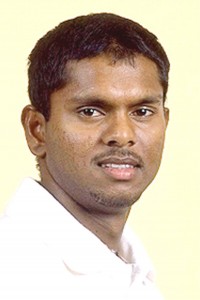By Tony Cozier
in CHRISTCHURCH
You don’t bat as long and face as many deliveries as Shivnarine Chanderpaul did in the West Indies’ cause in 2007 without some physical effects.

The legacy of the 2,904 balls the immovable left-hander had to deal with in 16 innings in Tests, 13 in ODIs and two in 20/20 Internationals in the past year – not counting the thousands of others against an assortment of net bowlers and bowling machines and in the middle for Guyana, Durham and in the Indian Premier League – has finally caught up with him.
Even though he values batting as much as life itself, he had to miss the first rain-ruined ODI of the five against New Zealand here on New Year’s Eve as he was being treated for the increasing discomfort of a tender left hand, between the thumb and forefinger.
It threatens to sideline him as well for the second match in Christchurch tomorrow night (tonight east Caribbean time).
“It’s just the constant jarring of the bottom hand against the handle,” Chanderpaul explained yesterday. “It was becoming more and more painful every time I bat so I thought it needed a rest before it got even worse.”
Virgil Browne, the former Leeward Islands left-arm spinner who is the team’s physiotherapist, has been treating it daily and an assessment on when Chanderpaul can play will be made on the morning of the match.
His absence leaves a huge hole, either in the middle order, as has been the norm in recent times, or as Chris Gayle’s opening partner, where he has been so effective in the past.
With 7,719 runs, nine hundreds and an average of 40.84 in 238 ODIs, Chanderpaul is irreplaceable in a batting line-up of severely limited experience and quality. And he remains hungry for runs, whatever the length of the game.
His 13 ODIs last year – against South Africa, Sri Lanka, Australia and Pakistan – brought him 578 runs at an average of 64.22. His second most recent innings was an unbeaten 107, off 149 balls, against Pakistan in Abu Dhabi in November.
His absence places additional pressure on captain Chris Gayle and Ramnaresh Sarwan at the top of the order. They are the only batsmen in the squad with more than 30 ODIs, the only ones who have hundreds to their name apart from Xavier Marshall’s 157 not out against Canada, an associate ICC team, in Toronto in August.
The only batting alternatives are Brendan Nash, Shaun Findlay, Kieron Pollard and Carlton Baugh, the second wicket-keeper.
Nash proved his worth in his vital innings in the Tests, but, much like Larry Gomes and Jimmy Adams, other left-handers of his method from earlier eras, his game is suited more to five than one day.
Pollard and Findlay are feeling their way and don’t seem up to it at this level. There is not much more to say about the choice of two keepers.
The situation supports Gayle’s point, made during the home series against Australia, that it is self-defeating to introduce so many new players at one time.
One of Runako Morton (49 ODIs, average 33.25, two hundreds) and Devon Smith (26 ODIs, average 23.27) would have lent necessary experience, even if not backed by imposing figures.
Surely, in the absence of Dwayne Bravo, Darren Sammy should have been here.
The West Indies were happy to ring out the old year and hope for better in one-day cricket in the new. There were three whitewashes in 2008 – 5-0 to South Africa and Australia, 3-0 to Pakistan – against a 2-0 triumph over Sri Lanka (one with Chanderpaul’s four and six off the last two balls, the other by the Duckworth/Lewis method) and 3-0 in the Toronto tournament involving Bermuda and Canada.
It is a shocking record. The first four ODIs of 2009 follow over the coming two weeks. Chanderpaul’s continuing absence would not bode well for an immediate improvement on 2008.





